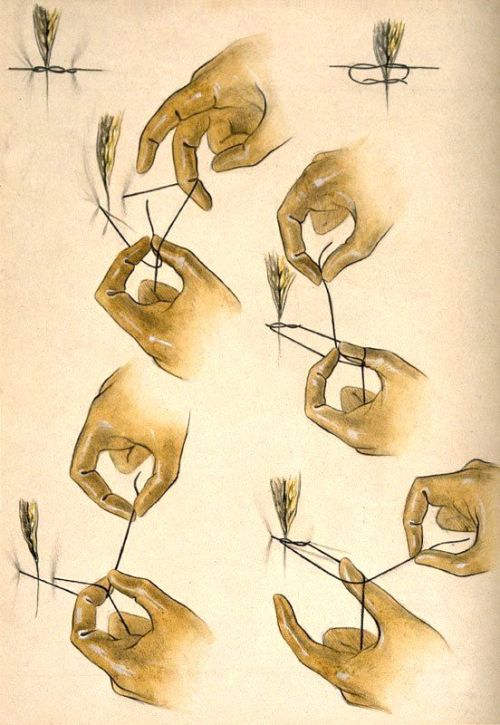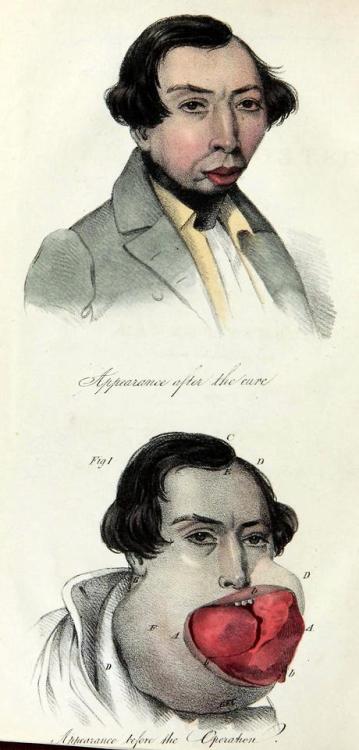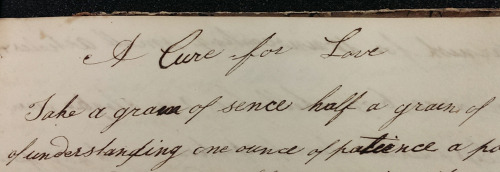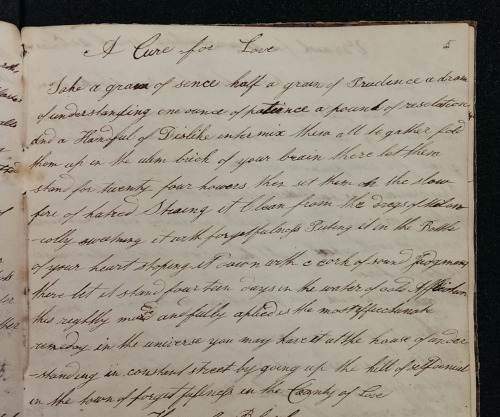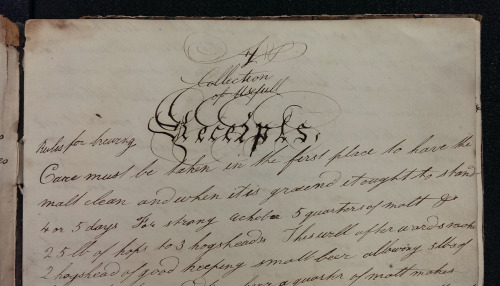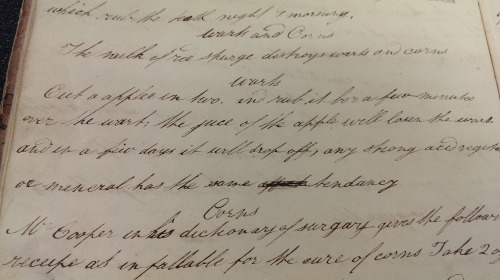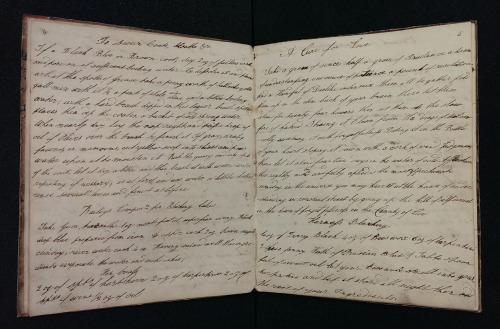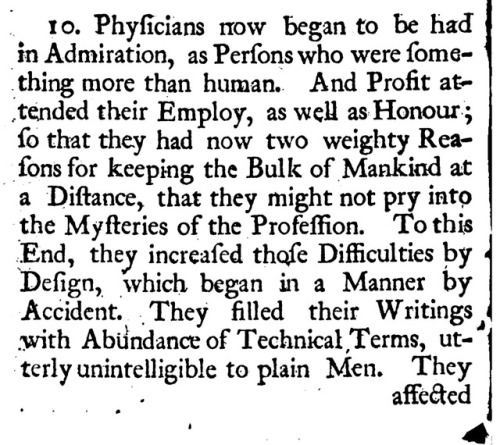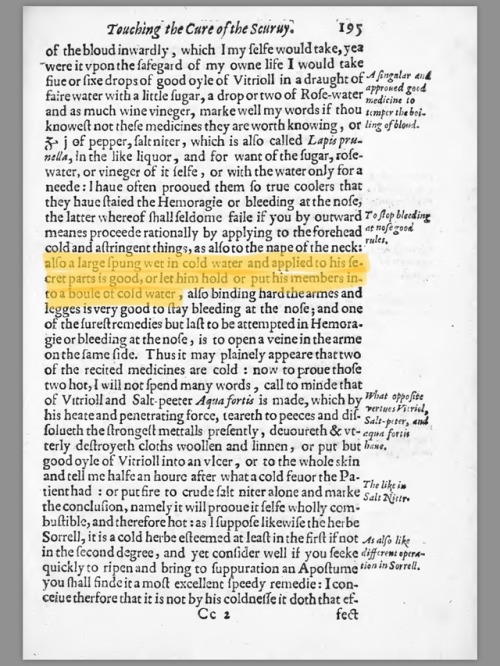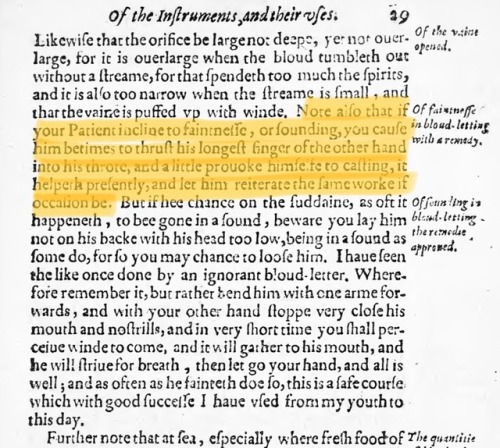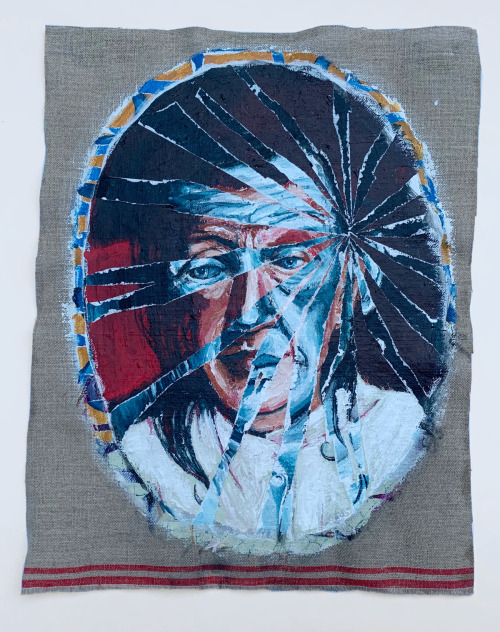#history of medicine
Trephination, or trepanning, is the oldest surgical procedure in the history of humankind. It’s so old that our earliest archeological evidence of the practice dates back to the Neolithic age. Cave paintings depict the procedure as an effort to relieve a type of demonic possession that we would now label epilepsy or a variety of other mental maladies. It was also used to removed broken bits of skull after trauma, and drain blood pooling between the skull and dura matter. The crazy thing about the prehistoric use of puncturing-a-hole-in-your-freaking-skull was that most of the wounds show signs of healing, indicating that these people most often survived the procedure. Other archeological evidence suggests that these people would wear the fragment of skull removed as a charm.
We still trephinate people today, typically to relieve the effects of severe head trauma and for craniectomy (unfortunately if you have this done today they won’t give you the bone to wear as a charm. I figure if I’m letting them crack open my skull the least they could do is give me a souvenir).
Post link
Could anyone give me any advice?
I’m currently in my final year studying BA History and Politics, and am in the process of applying for a scholarship to study MA History of Medicine. For the application I need to write an diss proposal, it only needs to be a side of A4 and I have some ideas but no idea how to tell if they have potential or where to take them from here. If anyone has any advice or experience with these sorts of applications or with the field it would be amazing to run some ideas past you. Thanks!
For Day 2 of #colorourcollections , we’ve decided to feature one of our favorite skeletons in Wilson Library Special Collections!
This particular skeleton is from De dissectione partium corporis humani libri tres(1545)–an anatomy text printed by the prolific printing family, the Estiennes.
Post link

Today jobs in the medical field are among America’s highest paid occupations. Not so in the 19th century. Not only was it a low-paying profession but it often garnered little popular respect (those leeches may have had something to do with it). Things got so desperate for one Victorian doctor that he took to robbing stagecoaches to make ends meet!
Learn more in Marketplace of the Marvelous by Erika Janik.

Despite the name, in 19th century America most “patent medicines” were never patented. To actually file for a patent would have required makers to reveal their secret ingredients, which most flat out refused to do. On the other hand, most did trademark their product names and label designs.
To find out about other questionable medical practices in Victorian America, check out a copy of Marketplace of the Marvelous by Erika Janik.

Feeling under the weather? Do what a Victorian would and grab a glass of sherry! In the 19th century alcohol was a medical mainstay in both regular and alternative medicine. First prescribed for its stimulant effects, the discovery of germs in the late 19th century turned alcohol into an internal cleanser!
To learn more about those crazy Victorians check out Marketplace of the Marvelous by Erika Janik.

Ah, those risk taking Victorians. Back in 19th century America, medical licensing laws were weak to non-existent. Just about anyone could practice medicine and call him or herself doctor. Until late in the century, many doctors never even attended medical school! As a result telling the difference between a doctor and a quack was next to impossible.
Learn more about the strange world of 19th century medicine in Marketplace of the Marvelous by Erika Janik.
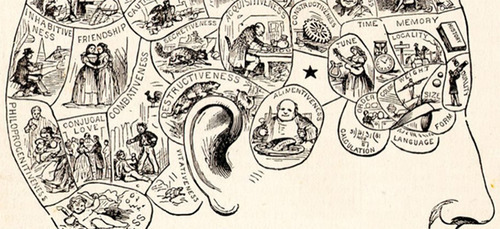
Educational standards and training at homeopathic medical schools often exceeded those of mainstream medical schools in the 19th century. Given that traditional Victorian medicine consisted of bloodletting (leeches, anyone?), trepanning, using mercury to treat… well, anything really, it’s not hard to understand the lure of homeopathy and it’s less terrifying approach.
Want to know more about those crazy Victorians and the path to modern medicine? Pick up Marketplace of the Marvelous by Erika Janik.

Angostura Bitters, Coca-Cola, Dr. Pepper, tonic water, and Hires Root Beer began life as patent medicines. So the next time you pick up your favorite tonic or pop, toast to your health! The Victorians would approve.
Learn more about the medicines and cures of the 19th century in Marketplace of the Marvelous by Erika Janik.

Homeopathy presented the biggest and most organized challenge to mainstream medical care in the 19th century. By 1898, homeopaths had 9 national and 33 state medical societies, 140 hospitals, 20 medical colleges, and 31 medical journals.
To learn more pick up a copy of Marketplace of the Marvelous by Erika Janik.

Elizabeth Blackwell is rightly celebrated as the first woman doctor in the United States. But her admission to Geneva Medical College in 1847 happened as a joke. The faculty opposed admitting a woman but unable to turn the otherwise qualified student down, they turned the decision over to the students who took the request as a gag. The students voted unanimously to admit her. Much to their surprise, Blackwell arrived for classes a few weeks later. Many mainstream medical schools refused to admit women until the 20th century so most of the first generations of female doctors came out of alternative medicine.
Learn more in Marketplace of the Marvelous by Erika Janik.

The idea of the brain as an organ divided into parts with different motor and sensory functions was popularized by phrenologist Franz Joseph Gall in the 18th century. Although the phrenological idea of reading personality on the bumps of your head was wrong (and totally weird), Gall’s fundamental idea of various brain functions being located in specific areas of the brain ultimately proved correct. Way to go FJ!
To learn more about the birth of modern medicine take a look at Marketplace of the Marvelous by Erika Janik.
Osteosarcoma, before and after operation
Osteosarcoma are cancerous bone tumors found in immature bone, most often in those over 10 and under 25 years old. This particular case is in a man named Robert Penman, who was twenty-four.
These days, in those whose tumor is non-malignant (has not spread beyond its original tumor site), the five-year survival rate is about 75%. Back in 1839, I cant imagine this lad was quite as lucky, but it appears that at least the primary tumor was removed for a time.
Case of Osteo-sarcoma of the lower jaw, as operated upon Robert Penman, aged twenty-four years. 1839.
Post link
“A skeleton of an adult put into this posture to show it in a greater scale. It was thought better not to figure it, all these bones being explained in former plates, and the design of this being to show them together without being defaced with references.”
The Anatomy of the Human Body. William Cheselden, 1750.
Post link
“A skeleton of an adult put into this posture to show it in a greater scale. It was thought better not to figure it, all these bones being explained in former plates, and the design of this being to show them together without being defaced with references.”
The Anatomy of the Human Body. William Cheselden, 1750.
Post link
New Jersey State Microbe Approved by Assembly
On February 25, 2019 The NJ Assembly unanimously voted in favor of designating an Official State Microbe, Streptomyces griseus. This brings NJ one step closer to being the second state in the US (and the world) to have a symbolic microbe.
This action sequence shows me (seated) casting the vote for Assemblywoman Annette Quijano (standing) in the Assembly Chamber. Wow, that was cool, and an honor! ASW Quijano was the principal sponsor in the Assembly. The vote was 76 to zero.
Strep griseus produces streptomycin, the first broad spectrum antibiotic and the first significant antibiotic found in America. It was discovered in 1943 in New Brunswick, NJ
Talk about pressure “Don’t press the red button!”
Please read my amazing microbiology book: https://tinyurl.com/Warhol-Small-Guide
More info:https://en.wikipedia.org/wiki/State_microbe
Post link
Valentine’s Day is nearly upon us! And while it can be a time of joy for many, for some it is more bittersweet, recalling memories of past heartache. If you fall into the latter camp this year, don’t fret—we uncovered the remedy you might need in an old manuscript recipe book.
“A Cure for Love” was penned on one page of this 19th century Collection of Useful Receipts, a handwritten book containing recipes for food as well as home remedies for various diseases and conditions. And while some of the directions might be a tad difficult to follow, we’ve been assured that this cure is the best around:
Take a gram of sence [sense] half a gram of Prudence a dram
of understanding one ounce of patience a pound of resolution
and a Handful of Dislike intermix them all together fold
them up in the [???] brick of your brain there let them
stand for twenty four howers [hours] then set them on the slow
fire of hatred Straing [?] it clean from the dregs of Melon-
-colly [melancholy] sweetning it with forgetfulness putting it in the Bottle
of your heart stop[p]ing it down with a cork of sound judgment
there let it stand fourteen days in the water of cold Affliction
this rightly made and fully ap[p]lied is the most effectunate [effectual?]
remedy in the universe you may have it at the house of under-
-standing in constant street by going up the hill of self denial
In the town of forgetfullness in the County of Love
This cure for love appears alongside many other medical remedies, including ointments for “warts and corns” and a supposed cure for smallpox. Whoever created this manuscript apparently considered love a very serious condition indeed.
http://catalog.lib.msu.edu/record=b10316781~S39a
~Andrew
Post link
A surgeon who wants to keep their patient from passing out during bloodletting should make them stick their middle finger down their throat and vomit.
Oh, and if they do pass out? The surgeon should pinch the patient’s nose and cover their mouth until they startle awake, gasping for air.
Post link
I have lost myself, so to say. Acrylic on linen, 2019. Based on a 1906 photograph of Auguste Deter, the first person to be diagnosed with Alzheimers.
Post link
As I’ve noted several times, I generally try to ignore whatever is currently passing for ‘governance’ in America at the moment, cuz I just ain’t got the patience, or ability to do all that emotional labour. However, they will keep on doing things that call back to the medieval period, so we’re gonna have to talk about it.
So currently in America, which is defo a first world country and for sure very prosperous and a good place to live, there is some debate about whether or not sick people should be driven into bankruptcy, given the audacity of their instance on being ill. (Have they tried not getting ill? IDK.)
Some Americans, who are for sure good Christians and well into Jesus, need you to know that no one should be obligated to help sick people pay for medical care. To whit:

How charming.
This idea – that health care is something that requires a) payment, and b) is an individual, not a community, concern is what we’re going to talk about today.
Now, as you may be aware, European medicine was underpinned by the idea of humorism which was central to Hippocratic medicine. Hippocratic medicine itself was developed from the tradition of Greek natural philosophy. Hippocrates, obviously, gave his name to the discipline, but the Hippocratic Corpus – a series of sixty some essays on medicine – was developed by several authors and compiled around 250 BCE. Galen then came along sometime around 129 AD and updated the ideas slightly, and notably had some influence on theories of anatomy and pharmacology, but was still a stan for humor theory.
As the theory went – the body held four humors: blood, yellow bile, black bile, and phlegm. These humors, in turn corresponded to the four seasons, the four elements, four temperaments, and four stages of the life cycle like so…

More or less, the idea was that if your humours were balanced you would remain healthy. If something got out of whack, you got sick. To get better you needed to get those humors back into balance. A lot of this idea was based on observation. If you were so sick to your stomach you were vomiting bile it sure did look like you had too much and your body was trying to rid itself of it. Bad cold? Same thing with phlegm.
Medieval medicine took this classical basis and ran with it. Classical medical texts were copied and edited in monasteries and monks also wrote their own works on herbal medicine and botany based off their own observations. As groups of devout Christian men with access to medical knowledge, monks considered it to be their religious obligation to provide medical care for members of their communities.

As a result, most monasteries ended up having a sort of informal hospital. Because they were actual fucking Christians.
There were a lot of other groups practicing medicine in the medieval period however. Barber surgeons, famously, did a lot of medical work that involved cutting people. Basically if you were able to keep a razor sharp enough to shave someone, odds were it was sharp enough to do minor surgery. Homeboys would do stuff like blood letting, dentistry, looking after soldiers during and after battle, and also keeping your cut fresh AF.

Barbers were medical professionals and for sure got paid. However, the medical services they provided were generally in reach of your average (read: peasant) medieval person.
There was also something for the ladiez to do medically – that is look after other ladiez. (Did you know that half of all people in the medieval period were actually women? No for real. I’m serious.) Midwifery was some real shit, and basically one of very few professional options for individual women at the time. (Fuck yeah the other option was sex work – shout out to my girls.)

Midwives were typically apprenticed at a young age in order to learn the trade, and had to have a reference from their parish priest as to their good character in order to do so. They then learned all about assisting the labour process. Labour was an exclusively female medical event – with men being excluded from the birth chamber. Midwives were certainly professionals, but the great majority of people (again, peasants) could still afford their services.
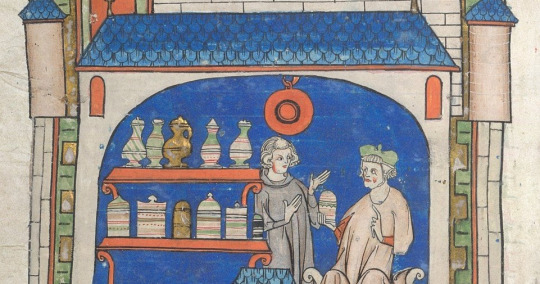
There were also straight up apothecaries who were sort of like modern day chemists/pharmacists who made drugs and medicines. By the thirteenth century they had their own guilds, and they often worked alongside other medical practitioners in order to establish what drugs should be made or
There were, of course, also dedicated physicians in the medieval period. There were several schools that taught medicine, including the much-celebrated Salerno, and later Montpellier, which is still in operation.

These institutions trained doctors including the famous Rogerius who wrote a killer book called The Practice of Surgery (Practica Chirurgiae) round about 1180, and also came up with the term ‘lupus’ and Giles de Corbeil who wrote a series of influential medical poems on the urinary tract and pulsology. The university system was making some pretty good advances in medicine, if slowly. People started doing more work with human dissection and learned more about anatomy. (Fun fact – high medieval Europe did not totally ban human dissection, but Pagan Rome did. Bring that up when people say the medieval period was backwards.)
The medical schools were drivers of medical thought and research and the people who trained in them often ended up working for the elite. You had to go to school for years to be licensed, and it wasn’t cheap, so you charged.
That’s where the trouble started.
After the Black Death showed up, people were not too enthused about medical practitioners. If they knew so much, why couldn’t they stop the plague?
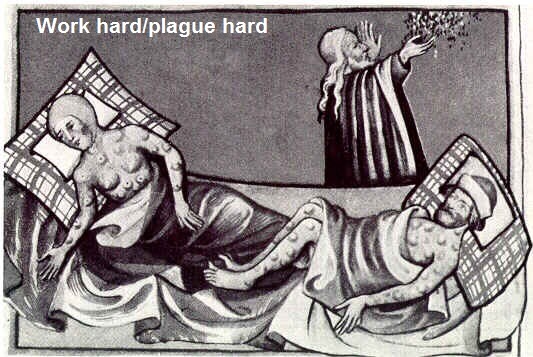
People began cracking down on non-licensed medical practitioners. If these people were actually skilled in terms of medicine then for real, why TF was everyone dying on the regular? Soon laws began to propagate stating that only licensed, i.e. university educated physicians could practice medicine. This fucked shit up.
Suddenly a lot of people who had been offering health care services couldn’t. The barber who pulled out your rotten teeth? Not licensed. Apothecaries who knew everything about how to create drugs? Part of a guild that learned through apprenticeship, not university. The monks who had killer medical libraries, actual running hospitals, and gardens full of medicinal herbs at their disposal? Only educated in the cloister.
It was even worse for women who could not go to university. In the medieval period all students had to take holy orders in order to join university, meaning that they were clergy members, if only for their time in school. Women couldn’t do that. That meant that there was no legal way for midwives to practice, despite the fact that only women were supposed to be involved in the birth of children.
So the ranks of people who could legally provide medical care suddenly dropped. Meanwhile, the only people who could legally provide it needed to see that cash money in order to provide medical care because they made a huge investment of time and money to get where they were.
In some instances, where you lived also determined whether or not you could get medical care. A trained physician would want to stay where the greatest number of potential (wealthy) clients lived. They, therefore, tended to stay in cities, or revolve around courts where their educational investments paid off. No one was going out to the country side to see to the peasants, you feel me? Moreover, the peasants couldn’t drag themselves off to a monastery for help when they got sick anymore, because monks weren’t supposed to be practicing medicine. There just wasn’t anywhere to go for help. By the early modern period, then, the poor had been stripped of a lot of the options they could exercise before.
All of this helped to create the system that America is experiencing today. Healthcare became a luxury – something that the rich elite had recourse to, and which everyone else had to do without. It is also a hugely modern ‘system’. No one is compelled by their religion to take care of the sick, despite the fact that America loves to call itself a Christian country. We compel bright young people who want to make money to go to med school, because there is a huge financial incentive. Being a medical doctor gets you paid. We do not tell them they have a responsibility to treat the sick when they are trained.
This health care system also routinely marginalises people who provide medical care but are not physicians, in particular those who are providing medical care in one of the traditionally ‘feminine’ roles. Nurses and midwives have much much more patient contact than doctors do, but are paid nowhere near as much. Hell, in America you might be paying out the nose for medical care and only ever see a nurse practitioner anyway, such are the vagaries of for-profit healthcare. So the nurse-practitioner ain’t getting paid, but you are still paying, and somehow all of this is fine and good.
None of this is to say that medical practitioners shouldn’t be paid for their services. It’s a hard job. You have to learn a lot. In the UK we really treat our junior doctors terribly and they deserve so much more. In the medieval period people still managed to treat people at all levels of society and still make a good living. The people who could afford to give away free health care in the medieval period (monks) had really comfortable life styles. The lower-level practitioners like barbers and midwives made their living on volume. There were options for patients and practitioners to enhance their quality of life.
Overall, then, while medicine has moved on from the medieval period and is much more effective – the healthcare options that many people in America have are actually much worse in comparison to what was available seven hundred years ago.
Perhaps even more distressing for enthusiasts of using ‘medieval’ to mean bad (which you should never do), is that America is a less caring society than Europe in the year 1300. Medieval Europeans were subject to strict class systems, many were unfree, and most lived lives of grinding poverty and work. Most people weren’t allowed to move down the road if they wanted to - but they were still considered deserving of health care.
Tell me one more time who the barbarians are.



